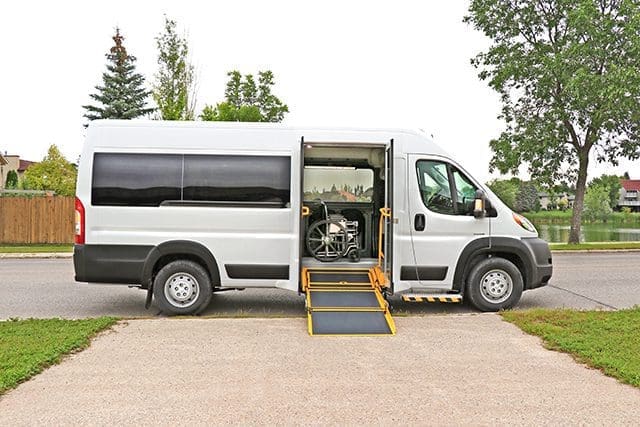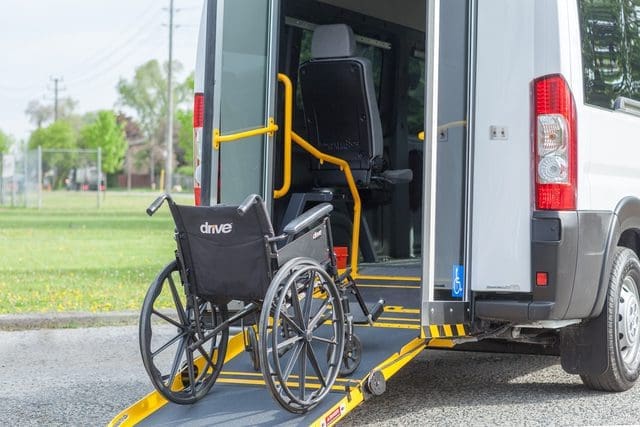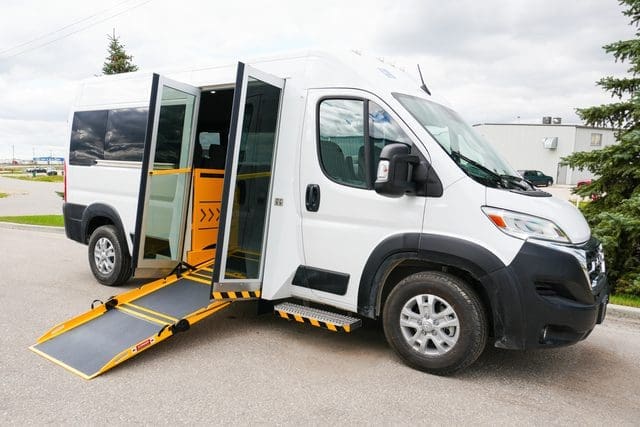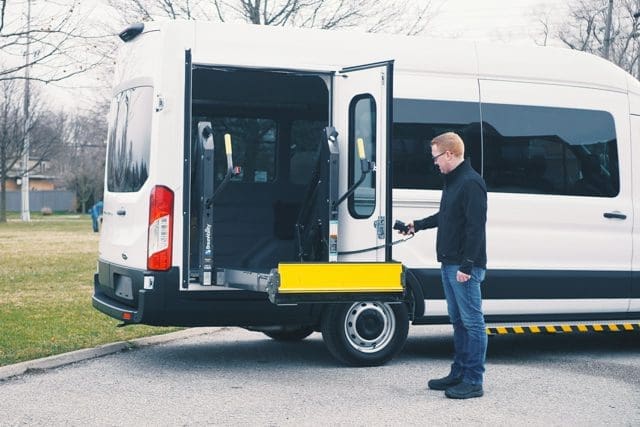What are the safety features on wheelchair van ramps, and why do they matter so much? Because when you’re helping people with limited mobility, even a small slip can have big consequences. A steep ramp incline, missing guardrails, or a ramp that wobbles; these are safety risks that could increase your liability.
If you’re an organization providing accessible transportation, you’ve likely felt this worry. Maybe it’s the fear of someone getting hurt, the stress of staff struggling with heavy equipment, or the unknown of buying a van and wondering, Are we covered when it comes to safety? Gaps like these can lead to injuries, legal issues, and a loss of trust from the people you serve.
But when wheelchair van ramps are designed with safety in mind, everything changes.
- People feel confident
- Loading is smooth
- Staff breathe easier
That’s the goal.
At MoveMobility, we’ve been building accessible vans for over 20 years. We’re Ford QVM and Stellantis QPro certified, and we’ve worked with organizations across Canada to create vehicles that reduce barriers, not add to them. And while we’re proud of what we build, this article is here to help you without bias.
As you read this article, you’ll learn about wheelchair van ramp safety features that will bring your organization and the clients you serve greater peace of mind.
Ready? Let’s get into it.
5 Safety features on wheelchair van ramps that protect passengers and staff
When it comes to safety features on wheelchair van ramps, the most important ones are the ones you don’t always see. These features work quietly in the background to keep everyone safe during loading and unloading. But without them, one small mistake could lead to a serious injury, or worse.
Let’s start with one of the most important features of all: the interlock system.
1. Interlock system: The “you’re not going anywhere” safety feature
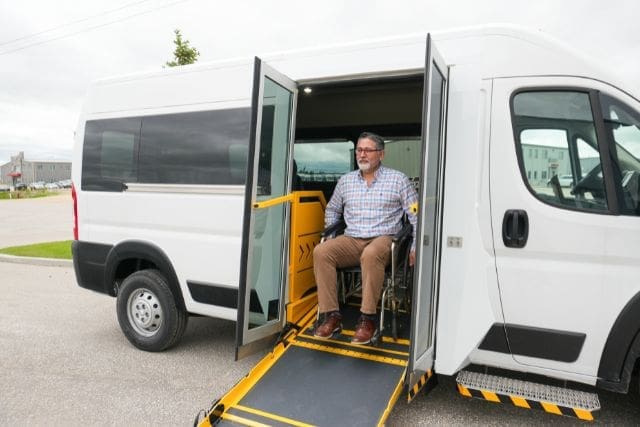
This one’s a big deal. The interlock system is like a built-in safety check that stops the van from moving while someone’s using the ramp or lift.
Here’s how it works:
- Vehicle must be in park
- Parking brake must be engaged
- Engine must be running
- Ramp is in use = no driving allowed
If any of these steps aren’t in place, the ramp won’t deploy. And if the ramp is out, the van can’t move. It’s that simple and that smart.
Why does this matter? Because distractions happen. People rush. Someone might accidentally throw it in drive without realizing a client is halfway down the ramp. The interlock system stops that from ever happening. It’s peace of mind for your team and a huge layer of protection for your passengers.
It’s a fail-safe, and every accessible van should have it.
Up next, let’s look at how grab bars play a big role in keeping people safe while using a wheelchair van ramp.
2. Grab bars: The extra set of hands everyone needs
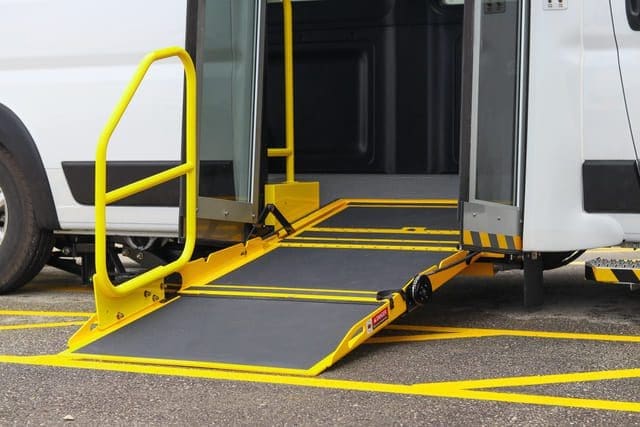
Another one of the most important safety features on wheelchair van ramps is something simple, but effective: Grab bars.
If you’ve ever watched someone navigate a ramp, you know it’s not always easy. Whether someone’s walking, using a walker, or rolling in a wheelchair, having something to hold onto gives extra control and confidence.
Grab bars are built right into the ramp area.
They’re strong, easy to grip, and help with:
- Balance: Clients can steady themselves going up or down
- Control: Helps caregivers safely guide someone using mobility aids
- Safety: Prevents falls, slips, or that scary moment when someone loses their footing
They’re especially helpful in Canadian weather, where rain, snow, and slush can make ramps on wheelchair vans slick. Even with a non-slip surface (which we’ll get to later), grab bars add a second line of defense.
Think of them like railings on a staircase. You might not always use them, but it’s always better to have them there when you need them.
So if you’re choosing a wheelchair van with a ramp, don’t skip this feature. It’s a small detail that makes a big difference for both passengers and staff.
Next, let’s talk about the weight capacity of wheelchair van ramps to promote a safer loading and unloading experience.
3. Weight capacity of wheelchair van ramps
Let’s talk about weight. One of the safety features on wheelchair van ramps that often gets overlooked is how much weight the ramp can actually handle. And in this case, bigger is better.
Most modern wheelchair ramps are rated for at least 1,000 pounds, and there’s a good reason for that.
1,000 lb capacity: Because people + equipment = heavy loads
Wheelchairs aren’t light. Add a powered wheelchair, a person, and maybe a caregiver helping out, and suddenly you’re pushing 600–800 lbs without breaking a sweat. That’s why the wheelchair van ramp safety features you choose need to be ready for real-world use.
Here’s what a 1,000 lb capacity helps prevent:
- Ramp bending or flexing under load
- Equipment damage from overload
- Unexpected ramp failure (yes, it can happen)
- Stress on caregivers trying to compensate for unsafe ramps
More capacity = more peace of mind. It also means you’re covered for heavier power chairs, bariatric equipment, or just the wear and tear of regular use.
You might not always need that much weight support, but when you do, it matters. It’s better to have it and never need it than to need it and realize you’re stuck.
Coming up next, we’ll take a look at how stowing keeps ramps out of the way as people safely enter and exit your wheelchair van.
4. Smart stowing
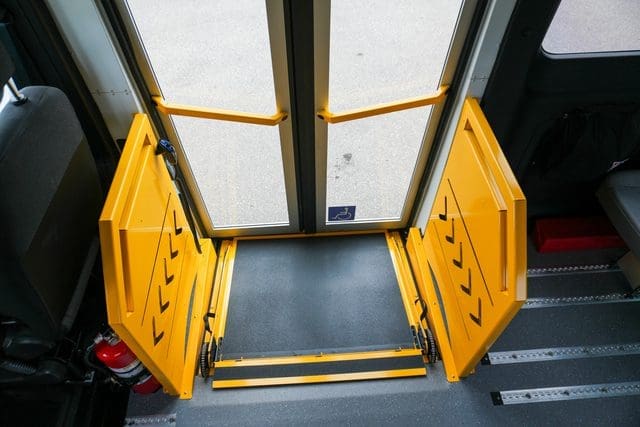
Some of the best safety features on wheelchair van ramps are the ones that make things smoother for everyone, not just the person using the ramp. And two of those features work hand in hand.
Let’s say you’ve got a group outing, or your van’s being used by both wheelchair users and ambulatory passengers. You don’t want the ramp in the way. You also don’t want people tripping, squeezing through tight spaces, or stepping over a folded-up ramp just to get inside.
Ramp doesn’t block the doorway when stowed
When the ramp folds up neatly against the side wall or floor, it stays out of the entry path.
That means:
- No tripping hazards
- Easy entry and exit for all passengers
- Safer movement inside the vehicle
Ramp can stay stowed for walk-on access
You don’t have to deploy the ramp every time someone gets in or out. If your passenger is walking in, the ramp stays put.
Why does this matter? Because every second counts in transportation. And nobody wants extra steps, extra movement, or unnecessary bending down to deal with gear that’s in the way.
Less clutter = fewer accidents. Simple as that.
The last safety feature we’ll look at is the manual backup system of wheelchair van ramps.
5. Manual backup system on wheelchair van ramps
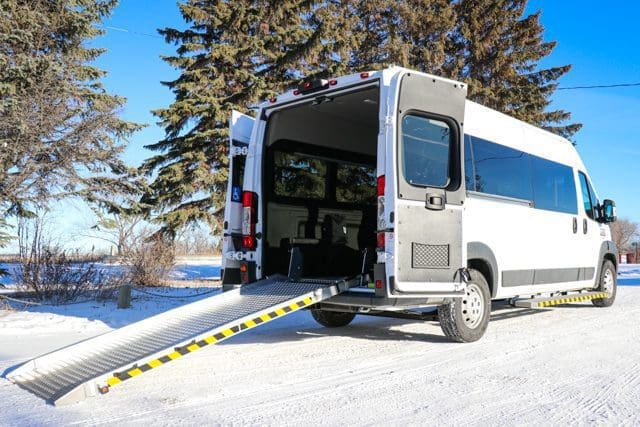
No one likes to think about equipment failing, but let’s be honest, power systems can sometimes break down. That’s why the manual backup system is one of the most overlooked but essential safety features on wheelchair van ramps.
When the ramp doesn’t deploy like it’s supposed to, a backup option can be the difference between a smooth day and a full-blown emergency.
If you’re using a powered ramp, consider the manual backup system your plan B if the power stops working.
Every accessible van should come with a way to operate the ramp manually. That might be a hand pump, a release lever, or a secondary latch system, whatever the method, the goal is the same:
- Keep people from getting stuck inside or outside
- Avoid having to call roadside assistance
- Stay on schedule when the ramp’s power fails
- Protect your team from lifting or unsafe workarounds
It’s not something you’ll use every day, and hopefully not often. But when you need it, it’s a lifesaver.
So when you’re comparing ramps on wheelchair vans, don’t forget to ask about the backup. It might feel like a small detail now, but in a pinch, it makes all the difference.
Need help choosing your next wheelchair van?
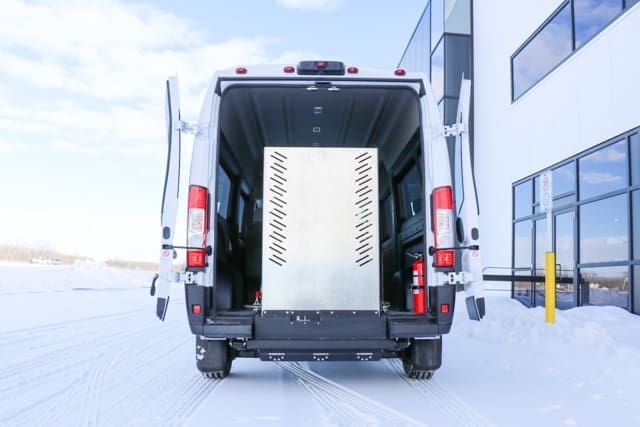
You came to this article because you’re likely feeling the weight of responsibility, knowing that safety matters and that the people you transport are counting on you. You might have been unsure about what makes a ramp actually safe, or worried about missing something that could put someone at risk.
Now, you’ve got a clearer picture. Here’s what you’ve learned:
- Interlock systems stop the van from moving when the ramp is in use
- Grab bars help with stability and reduce fall risks
- 1,000 lb capacity ramps support heavy equipment and powered chairs
- Smart stowing keeps entryways clear and prevents trip hazards
- Manual backups give you peace of mind in a power failure
At MoveMobility, we build more than just vehicles; we build trust. With over two decades of experience, deep partnerships across Canada, and a passion for solving real-world problems, we’ve helped organizations like yours move from uncertainty to confidence. We’re here to make your job easier, safer, and more reliable, so you can focus on helping others.
We’re proud to lead the way in barrier-free transportation, and we’re always just a click away. If you have questions, hit the button below and talk to a mobility expert who’s ready to help.
If you’re not ready to chat just yet, no problem, we’ve got more helpful resources waiting for you.
Start by checking out our article on manual ramps and powered ramps to determine which option is better for your organization and clients.
If you’re trying to decide between a ramp or a lift for your wheelchair van, read our article on that to learn more or watch the video below.


